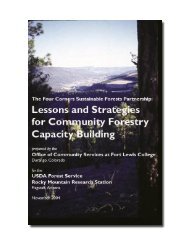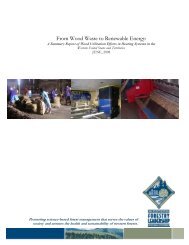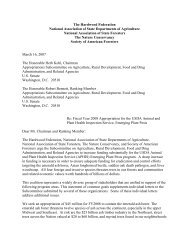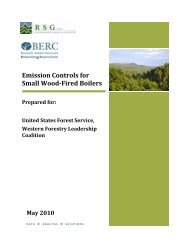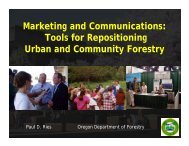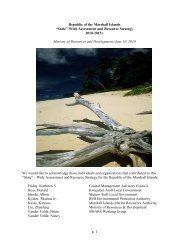Legislative and Policy Update from the WFLC - Western Forestry ...
Legislative and Policy Update from the WFLC - Western Forestry ...
Legislative and Policy Update from the WFLC - Western Forestry ...
You also want an ePaper? Increase the reach of your titles
YUMPU automatically turns print PDFs into web optimized ePapers that Google loves.
WESTERN FORESTRY LEADERSHIP COALITION<br />
LEGISLATIVE & POLICY UPDATE<br />
Tuesday, August 17, 2010<br />
Brent Keith, Governmental Affairs Director: 303.445.4366, brent.keith@colostate.edu<br />
The <strong>Western</strong> <strong>Forestry</strong> Leadership Coalition (<strong>WFLC</strong>) <strong>Legislative</strong> & <strong>Policy</strong> <strong>Update</strong> provides<br />
information on issues of importance to <strong>the</strong> <strong>WFLC</strong> <strong>and</strong> our partner groups. This document is<br />
posted at www.wflcweb.org/infomaterials/issue_briefs.php. Please note that <strong>the</strong> items below<br />
highlight only a few of <strong>the</strong> issues <strong>the</strong> <strong>WFLC</strong> is currently tracking.<br />
1. FY 2011 Appropriations<br />
The appropriations process is behind schedule this year <strong>and</strong> a strong likelihood remains that a<br />
Continuing Resolution (CR) will be used to continue funding federal programs for at least <strong>the</strong><br />
first quarter of FY 2011. The Council of <strong>Western</strong> State Forester’s (CWSF) FY 2011<br />
Appropriations Priorities, including specific funding recommendations, are available online at<br />
http://wflccenter.org/infomaterials/issue_briefs.php.<br />
Interior <strong>and</strong> Related Agencies Appropriations: The Senate has approved an overall budget<br />
allocation for FY 2011 that cuts spending by $14 billion <strong>from</strong> <strong>the</strong> President’s proposed budget,<br />
however <strong>the</strong> Senate Subcommittee on Interior, Environment <strong>and</strong> Related Agencies has not held a<br />
markup of an FY 2011 spending bill. In <strong>the</strong> House, <strong>the</strong> Subcommittee on Interior, Environment<br />
<strong>and</strong> Related Agencies approved a spending bill, although <strong>the</strong> full House Committee on<br />
Appropriations has not yet considered <strong>the</strong> bill. The text of <strong>the</strong> bill approved by <strong>the</strong> House<br />
Subcommittee has not been released, so program specific funding levels are not available. The<br />
Subcommittee did fund <strong>the</strong> accounts contemplated under <strong>the</strong> Federal L<strong>and</strong> Assistance,<br />
Management <strong>and</strong> Enhancement Act (FLAME Act). The FLAME accounts are to be used for<br />
wildl<strong>and</strong> fire suppression expenses that meet access criteria under <strong>the</strong> Act. The accounts are<br />
designed to address up-front budget constraints related to rising fire suppression costs <strong>and</strong><br />
eliminate <strong>the</strong> need for <strong>the</strong> Forest Service <strong>and</strong> Department of Interior fire agencies to transfer<br />
funds <strong>from</strong> non-fire programs. Including <strong>the</strong> FLAME accounts, overall suppression funding in<br />
<strong>the</strong> House Subcommittee was set at <strong>the</strong> ten-year average, adjusted for inflation. It is unclear<br />
when <strong>the</strong> full House Committee on Appropriations will consider <strong>the</strong> Interior <strong>and</strong> Related<br />
Agencies bill.<br />
Agriculture Appropriations: Appropriations subcommittees in both <strong>the</strong> House <strong>and</strong> Senate have<br />
approved Agriculture spending bills; however nei<strong>the</strong>r full appropriations committee in <strong>the</strong> House<br />
or Senate has weighed in on <strong>the</strong> bills. During <strong>the</strong> Subcommittee hearing in <strong>the</strong> House, numerous<br />
amendments were offered that would have cut overall spending in <strong>the</strong> bill, however <strong>the</strong>se<br />
amendments were ultimately rejected <strong>and</strong> funding levels for conservation programs in <strong>the</strong><br />
Agriculture spending bill such as <strong>the</strong> Environmental Quality Incentives Program, Wildlife<br />
Habitat Incentives Program <strong>and</strong> <strong>the</strong> Conservation Stewardship Program appear to have survived<br />
relatively unsca<strong>the</strong>d.<br />
<strong>WFLC</strong> <strong>Legislative</strong> & <strong>Policy</strong> <strong>Update</strong><br />
August 17, 2010 Page 1 of 3
2. USDA Forest Service Planning Rule<br />
On July 29 th <strong>and</strong> 30 th , <strong>the</strong> USDA Forest Service (USFS) held <strong>the</strong> Fourth National Roundtable on<br />
<strong>the</strong> Forest Service Planning Rule in Washington, DC. The purpose of this meeting was to<br />
present <strong>the</strong> concepts <strong>and</strong> approaches being developed by <strong>the</strong> USFS Planning Rule Team to<br />
interested stakeholders for <strong>the</strong>ir review <strong>and</strong> comment. Tony Tooke, Director of Ecosystem<br />
Management Coordination with <strong>the</strong> USFS, led <strong>the</strong> plenary sessions <strong>and</strong> provided an overview of<br />
<strong>the</strong> proposed framework for <strong>the</strong> Planning Rule. Prior to <strong>the</strong> meeting, <strong>the</strong> USFS provided a Draft<br />
Planning Rule Framework along with posts on how <strong>the</strong> rule might address Collaboration,<br />
Monitoring, People <strong>and</strong> <strong>the</strong> Environment, Recreation, All L<strong>and</strong>s, Climate Change <strong>and</strong><br />
Watersheds on <strong>the</strong> Planning Rule Blog (http://planningrule.blogs.usda.gov/).<br />
At <strong>the</strong> roundtable, USFS Chief Tom Tidwell discussed <strong>the</strong> importance of creating a rule that is<br />
both adaptable <strong>and</strong> science based, <strong>and</strong> fur<strong>the</strong>r focused on <strong>the</strong> importance of stakeholder<br />
involvement <strong>and</strong> direction in developing <strong>the</strong> rule. The basic framework proposed by <strong>the</strong> USFS<br />
Planning Rule Team would follow an iterative three step process of (1) Assess, (2) Revise or<br />
Amend, <strong>and</strong> (3) Monitor. The Planning Rule Team expects to release a proposed rule <strong>and</strong> draft<br />
environmental impact statement before <strong>the</strong> end of 2010 <strong>and</strong> ultimately believes <strong>the</strong>y are still on<br />
track to complete <strong>the</strong> rule <strong>and</strong> environmental impact statement in November of 2011.<br />
The CWSF has been following <strong>the</strong> work of <strong>the</strong> USFS Planning Rule Team <strong>and</strong> developed Key<br />
Principles Guiding State Forester Engagement in Drafting <strong>the</strong> National Forest System L<strong>and</strong><br />
Management Planning Rule (available at http://wflccenter.org/infomaterials/issue_briefs.php) to<br />
guide <strong>and</strong> inform CWSF interaction on <strong>the</strong> planning rule. These principles were shared with <strong>the</strong><br />
USFS Planning Rule team at <strong>the</strong> Fourth National Roundtable <strong>and</strong> on <strong>the</strong> planning rule blog.<br />
Materials <strong>from</strong> <strong>the</strong> Fourth National Roundtable are available on <strong>the</strong> Planning Rule Website at<br />
http://planningrule.blogs.usda.gov/files/2010/07/FourthRoundtableMeetingMaterials.pdf.<br />
3. National Forest Insect <strong>and</strong> Disease Emergency Act of 2010<br />
On August 5, 2010, <strong>the</strong> U.S. Senate Committee on Energy & Natural Resources approved a<br />
number of energy <strong>and</strong> public l<strong>and</strong>s bills, including <strong>the</strong> National Forest Insect <strong>and</strong> Disease<br />
Emergency Act of 2010 (S. 2798). These bills are now eligible for consideration by <strong>the</strong> full<br />
Senate, however it is not clear when or if <strong>the</strong> entire body will take up any of <strong>the</strong>se bills, or if <strong>the</strong>y<br />
will include <strong>the</strong>m in an omnibus package once <strong>the</strong> Senate reconvenes in September.<br />
The CWSF has been monitoring this bill <strong>and</strong> will work with partners <strong>and</strong> staff as necessary to<br />
address concerns with <strong>the</strong> current language. Of primary interest to <strong>the</strong> CWSF are <strong>the</strong> changes to<br />
<strong>the</strong> Good Neighbor Authority (GNA) in S. 2798 as approved by <strong>the</strong> Committee. While <strong>the</strong><br />
language of <strong>the</strong> amended <strong>and</strong> approved bill would exp<strong>and</strong> <strong>the</strong> GNA to additional western states,<br />
it would also significantly reduce <strong>the</strong> utility of <strong>the</strong> authority.<br />
The GNA is currently available in Colorado <strong>and</strong> Utah <strong>and</strong> enables <strong>the</strong>se states to enter into<br />
agreements with <strong>the</strong> USDA Forest Service to implement management activities on federal l<strong>and</strong>s.<br />
The GNA provides flexibility to l<strong>and</strong> managers <strong>and</strong> is an effective tool in addressing forest<br />
health <strong>and</strong> community safety issues across management boundaries.<br />
<strong>WFLC</strong> <strong>Legislative</strong> & <strong>Policy</strong> <strong>Update</strong><br />
August 17, 2010 Page 2 of 3
4. 2012 Farm Bill<br />
Both <strong>the</strong> House Committee on Agriculture <strong>and</strong> <strong>the</strong> Senate Committee on Agriculture, Nutrition<br />
<strong>and</strong> <strong>Forestry</strong> have already begun holding hearings to review programs in preparation for <strong>the</strong> 2012<br />
Farm Bill. As discussion of <strong>the</strong> 2012 Farm Bill continues, <strong>the</strong> Forests in <strong>the</strong> Farm Bill Coalition<br />
may reconvene. This group worked to increase opportunities for America’s private forest<br />
l<strong>and</strong>owners to provide economic <strong>and</strong> environmental benefits to <strong>the</strong> larger society in <strong>the</strong> 2008<br />
Farm Bill. Additionally, <strong>the</strong> CWSF is working on a Farm Bill platform based around <strong>the</strong><br />
recommendations in <strong>the</strong> <strong>WFLC</strong> Threats to <strong>Western</strong> Private Forests: A Framework for<br />
Conserving <strong>and</strong> Enhancing <strong>the</strong> Benefits <strong>from</strong> Private Working Forests in <strong>the</strong> <strong>Western</strong> U.S. The<br />
Threats to <strong>Western</strong> Private Forests report is available at http://www.wflcweb.org/forestthreats/.<br />
For more information contact Brent Keith, Governmental Affairs Director, 303.445.4366 or<br />
brent.keith@colostate.edu.<br />
#####END#####<br />
<strong>WFLC</strong> <strong>Legislative</strong> & <strong>Policy</strong> <strong>Update</strong><br />
August 17, 2010 Page 3 of 3



